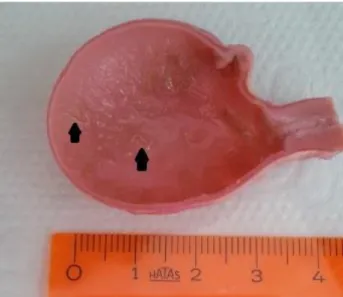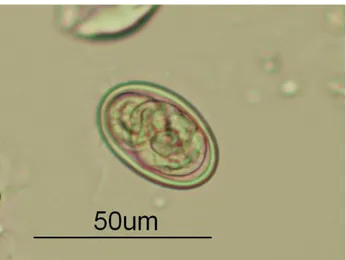Ankara Üniv Vet Fak Derg, 64, 65-68, 2017
Short Communication / Kısa Bilimsel Çalışma
A case of Synhimantus (Synhimantus) laticeps (Rudolphi, 1819)
Railliet, Henry and Sisoff, 1912 (Nematoda, Acuariidae) in common
kestrel (Falco tinnunculus)
Ceren AŞTI, Görkem CENGİZ, Hıfsı Oğuz SARIMEHMETOĞLU
Ankara University, Faculty of Veterinary Medicine, Department of Parasitology, Ankara, Turkey.Summary: Twelve female and one male nematodes were identified as Synhimantus (Synhimantus) laticeps from a stomach of
common kestrel (Falco tinnunculus) which was brought to Ankara University Faculty of Veterinary Medicine, Laboratory of Parasitology Department. Parasites were examined and measured under microscope, and photos of important parts for the diagnosis were taken. This study has importance as it is the first case about kestrels in Turkey.
Keywords: Common kestrel, Falco tinnunculus, stomach, Synhimantus (S) laticeps.
Bir bayağı kerkenezde (Falco tinnunculus) Synhimantus (Synhimantus) laticeps (Rudolphi, 1819)
Railliet, Henry ve Sisoff, 1912 (Nematoda, Acuariidae) olgusu
Özet: Bu çalışmada, Ankara Üniversitesi Veteriner Fakültesi Parazitoloji Anabilim Dalı laboratuvarına getirilen bir kerkenezin
(Falco tinnunculus) midesinden toplanan 12 dişi ve bir erkek nematodun ölçümleri yapılmış ve teşhis için önemli morfolojik yapıların fotoğrafları çekilerek Synhimantus (Synhimantus) laticeps türüne ait oldukları belirlenmiştir. Bu çalışma, Türkiye’de kerkenezlerde bildirilen ilk olgu olması açısından önem taşımaktadır.
Anahtar sözcükler: Falco tinnunculus, kerkenez, mide, Synhimantus (S) laticeps.
Acuariidae is a very large family related to Spirurida
order Acuarioidea superfamily. This family includes genera such as Acuaria, Aviculariella, Cheurexia,
Cosmocephalus, Dispharynx, Echinuria, Seuratia, Synhimantus etc (22). After Chaboud (1975), Dispharynx,
has been examined under Synhimantus. Synhimantus
(Dispharynx) genus is seperated from that of Synhimantus (Synhimantus) in that it is in front of the body and by the
fact that cordons which are specific to these parasites are not anostomosing with each other (11, 14, 21, 22, 24).
Synhimantus (S.) species are located in gizzard,
oesophagus, glandulous and muscular ventriculus of many poultry as well as their small intestine, and which can cause mucosal oedema, multifocal petechial bleeding, catarrhal exudate, papillomatous formations and ulcers in the giblets (5, 16, 18). The parasite has cosmopolite distribution and it was reported from Europe (Bulgaria, France, Germany, Spain) (1, 7, 10, 20, 22), Asia (China, Iraq, Japan, Russia) (2, 5), Africa (Algeria, Egypt) (5), South America (Cuba, Brazil) and Australia (5, 12, 23).
Two species of Synhimantus were recorded from different birds in Turkey. These are Synhimantus (S.)
laticeps reported from hawk (21) and falcon (19), while S.
(Dispharynx) nasuta from chicken (13, 15), magpie (6)
and pigeon (8, 9).
In this study, 13 adult Synhimantus (S.) laticeps (12 females and 1 male) are collected from stomach of a kestrel (Figure 1).
Common kestrel (Falco tinnunculus; Falconiformes;
Falconidae) is one of daylight predatory birds which can
be seen at mountains, valleys, forestlands and moorlands, farming areas or even in urban areas. In their natural habitat, they can travel to long distance and feed small mammals, birds, reptiles and insects (3, 4).
A stomach of common kestrel, which was sent in December 2014 to our laboratory, composes the study material. After the stomach was washed with physiological saline solution (FTS), parasites which are located in mucosa are gathered with fine forceps and washed in FTS. Collected parasites were fixed in 70% warm alcohol and kept in glycerine alcohol (5% glycerine+ 95% (70%) alcohol) until measurements were carried out. After parasites were make pellucid in lactophenol, they were examined and measured under microscope, and photos of important parts for the diagnosis were taken.
Ceren Aştı - Görkem Cengiz - Hıfsı Oğuz Sarımehmetoğlu 66
Figure 1. Adult parasites located in mucosa of stomach. Şekil 1. Mide mukozasına yerleşmiş olgun parazitler.
Females (n=12) were measured 6.28-10.86 mm length, 3.08-5.59 mm wide; 2009,39- 3720,36 µm glandulous oesophagus length; 407,84-1084,27 µm muscular oesophagus length; 555,96-1412,04 µm cordon length; 309,96-5083,17 µm distance of the vulva to back end. Eggs which are oval-shaped, thick skinned and developed or developing were carrying embryos. Egg measurements were 36,90-44,28 X length 22,14-24,60 µm wide.
Male (n=1) was measured 5.93 mm length, 2.38 mm wide. Muscular oesophagus length 329,64 µm; 398,52 µm cordon length; 258,63 µm right spiculum length; 706,27 µm left spiculum length. The spiculums were seen in complex structure. Distance of the spiculum to back end was 250,92 µm.
The important structures and egg of Synhimantus (S.)
laticeps photos are given in Figures 2, 3, 4.
Figure 2. A. Front end of female Synhimantus (Synhimantus) laticeps. B. Anostomosed cordons C. Pseudolabia and buccal capsule. Şekil 2. A. Dişi Synhimantus (Synhimantus) latiseps’in ön ucu. B. Anastomozlaşan kordonlar. C. Pseudolabia ve ağız kapsülü.
Ankara Üniv Vet Fak Derg, 64, 2017 67
Figure 4. Egg of Synhimantus (Synhimantus) laticeps. Şekil 4. Synhimantus (Synhimantus) latiseps yumurtası.
Morphological features gathered from the study are compatible with classical informations (11, 14, 18, 22). The parasite measurements values are similar to those of literature knowledge with little differences. These differences are considered to arise from host species (1, 21).
Synhimantus (S.) laticeps cases in Spain were
reported by Sanmartin et al. (17) and Acosta et al. (1) before from common kestrels. This study has importance as it is the first case from Synhimantus (S.) laticeps in kestrels in Turkey.
Acknowledgements
We thank to Ankara University, Faculty of Veterinary Medicine, Department of Histology and Embryology for providing the material of this study.
References
1. Acosta I, Hernandez S, Gutierrez PN, et al. (2010):
Acuaroid nematodes in the common kestrel (Falco tinnunculus) in the south of Spain. Vet J, 183, 234-237.
Figure 3. D. Back end of male Synhimantus (Synhimantus) laticeps. E. Back end of female parasites. F-G. Vulva. Şekil 3. D. Erkek Synhimantus (Synhimantus) latiseps’in arka ucu. E. Dişi arka uç. F-G. Vulva.
Ceren Aştı - Görkem Cengiz - Hıfsı Oğuz Sarımehmetoğlu 68
2. Al-Barwari S, Saeed I (2012): The parasitic communities
of the rock pigeon Columba livia from Iraq: Component and importance. Turkiye Parazitol Derg, 39, 232-239.
3. Anonim (2015a): Turkiye’nin anonim kuşları- kuş türleri
detaylı bilgiler
http://www.trakus.org/kods_bird/uye/?fsx=2fsdl17@d&tur =Kerkenez (25.05.2015).
4. Anonymous (2015b): Kestrel
http://www.en.wikipedia.org/wiki/Kestrel (12.05.2015). 5. Carreno RA (2008): Dispharynx, Echinuria, and
Streptocara. 326-342. In: CT Atkinson, NJ Thomas, DB
Hunter (Eds), Parasitic Diseases of Wild Birds. Wiley-Blackwell, Iowa.
6. Çetindağ M, Bıyıkoğlu G (1997): Türkiye'de saksağan
(Pica pica)'larda Dispharynx nasuta (Rudolphi, 1819) ve Trichomonas sp. bulgusu. Etlik Vet Mikrob Derg, 1,
149-156.
7. Ferrer D, Molina R, Castella J, et al. (2004): Parasitic
helminths in the digestive tract of six species of owls (Strigiformes) in Spain. Vet J, 167, 181-185.
8. Gıcık Y (1997): Yabani bir güvercinde (Columba livia)
Dispharynx nasuta (Rudolphi, 1819) olgusu. Ankara Univ
Vet Fak Derg, 44, 1-3.
9. Gıcık Y, Burgu A (2000): Ankara ve çevresinde yaban
güvercinlerde helmint faunası. Kafkas Univ Vet Fak Derg,
6, 1-7.
10. Illescas MP, Rodrigues M, Aranda F (1993): Parasitation
of falconiform, strigiform and passeriform (Corvidae) by helminthes in Spain. Res Rev Parasitol, 53, 129-135.
11. Kotlan A (1960): Nematoden als parasiten der haus-und
nutziere sowie des menschen. 522-523. In: Helminthologie,
Budapest.
12. Kutzer E, Frey H, Nöbauer H (1982): Parasite fauna of
Austrian owls (Strigiformes). Angew Parasitol, 23, 190-197.
13. Merdivenci A (1967): Türkiye'nin Marmara Bölgesinde
Evcil Tavuk, Hindi, Ördek ve Kazlarda Görülen Trematod, Sestod ve Nematodlara Dair Araştırmalar. Istanbul Univ
Tıp Fak Yayın, 37. Kutulmuş Matbaası, İstanbul.
14. Mönnig HO (1950): Veterinary Helminthology and
Entomology: The Diseases of Domesticated Animals Caused by Helminth and Arthropod Parasites. 3rd Ed,
Baltimore The Williams & Wilkins Company, Great Britain.
15. Orunc O, Bicek K (2009): Determination of parasite fauna
of chicken in the Van region. Turkiye Parasitol Derg, 33,
162-164.
16. Rickard LG (1985): Proventricular lesions associated with
natural and experimental infections of Dispharynx nasuta (Nematoda: Acuariidae). Can J Zool, 63, 2663-2668.
17. Sanmartin ML, Alvarez F, Barreiro G, et al. (2004):
Helminth fauna of Falconiform and Strigiform birds of prey in Galicia, Northwest Spain. Parasitol Res, 92, 255-263.
18. Soulsby EJL (1986): Helminths, Arthropods and Protozoa
of Domesticated Animals. 7th Ed. Bailliere Tindall, London.
19. Tezel M, Girişgin AO, Birlik S, et al. (2015): Helminths
of the digestive tract in Buteo buteo (Falconiformes: Falconidae) in Bursa province of northwest Turkey. Turk J
Zool, 39, 323-327.
20. Thebault FHJ (1988): Les parasites des oiseaux de proie.
Etude nécropsique des helminthes rencontrés chez les rapaces de la région toulousaine. These pour le doctorat
veterinaire. Ecole Nationale Veterinaire de Toulouse. 176pp.
21. Umur S, Beyhan YE, Pekmezci GZ, et al. (2010): First
record of Synhimantus (S.) laticeps (Rudolphi, 1819) Railliet, Henry et Sisoff, 1912 (Nematoda, Acuariidae) in Accipiter nisus (Aves, Accipitridae) in Turkey. Ankara Univ
Vet Fak Derg, 57, 139-142.
22. Yamaguti S (1961): Systema Helminthum. 1st Ed, Interscience Publishers, New York.
23. Zhang L, Beveridge I (2007): Description of Synhimantus
(Dispharynx) mawsonae n. Sp. and a redescription of Procyrnea dollfusi (Mawson, 1968) (Nematoda: Spirurida) from the southern boobook owl, Ninox Boobook (Latham, 1802) (Aves: Strigidae). Trans Roy Soc S Aust, 132,
152-159.
24. Zhang L, Brooks DR, Causey D (2004): Two species of
Synhimantus (Dispharynx) Railliet, Henry and Sisoff, 1912 (Nematoda: Acuarioidea: Acuariidae), in passerine birds from the area de Conservacion Guanacaste, Costa Rica. J
Parasitol, 90, 1133-1138.
Geliş tarihi: 11.08.2015 /Kabul tarihi:21.03.2016
Adress for correspondence:
Prof. Dr. Hıfsı Oguz SARIMEHMETOGLU Ankara University
Faculty of Veterinary Medicine Department of Parasitology

